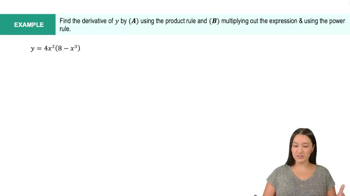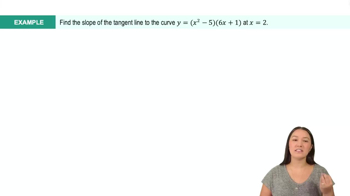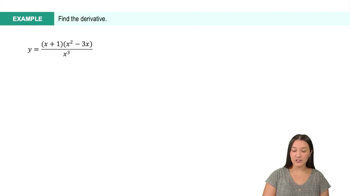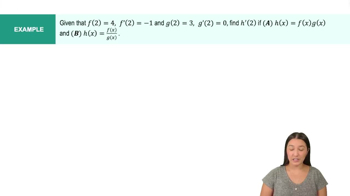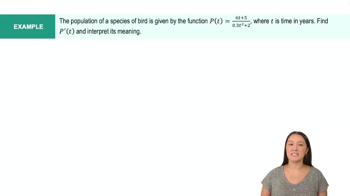Table of contents
- 0. Functions7h 52m
- Introduction to Functions16m
- Piecewise Functions10m
- Properties of Functions9m
- Common Functions1h 8m
- Transformations5m
- Combining Functions27m
- Exponent rules32m
- Exponential Functions28m
- Logarithmic Functions24m
- Properties of Logarithms34m
- Exponential & Logarithmic Equations35m
- Introduction to Trigonometric Functions38m
- Graphs of Trigonometric Functions44m
- Trigonometric Identities47m
- Inverse Trigonometric Functions48m
- 1. Limits and Continuity2h 2m
- 2. Intro to Derivatives1h 33m
- 3. Techniques of Differentiation3h 18m
- 4. Applications of Derivatives2h 38m
- 5. Graphical Applications of Derivatives6h 2m
- 6. Derivatives of Inverse, Exponential, & Logarithmic Functions2h 37m
- 7. Antiderivatives & Indefinite Integrals1h 26m
- 8. Definite Integrals4h 44m
- 9. Graphical Applications of Integrals2h 27m
- 10. Physics Applications of Integrals 2h 22m
3. Techniques of Differentiation
Product and Quotient Rules
Problem 9a
Textbook Question
Find the derivative the following ways:
Using the Product Rule or the Quotient Rule. Simplify your result.
f(x) = (x - 1)(3x + 4)
 Verified step by step guidance
Verified step by step guidance1
Step 1: Identify the functions to apply the Product Rule. Here, we have two functions: \( u(x) = x - 1 \) and \( v(x) = 3x + 4 \).
Step 2: Recall the Product Rule formula: \( (uv)' = u'v + uv' \). This means we need to find the derivatives of \( u(x) \) and \( v(x) \).
Step 3: Differentiate \( u(x) = x - 1 \). The derivative \( u'(x) \) is 1, since the derivative of \( x \) is 1 and the derivative of a constant is 0.
Step 4: Differentiate \( v(x) = 3x + 4 \). The derivative \( v'(x) \) is 3, since the derivative of \( 3x \) is 3 and the derivative of a constant is 0.
Step 5: Apply the Product Rule: \( f'(x) = u'v + uv' = (1)(3x + 4) + (x - 1)(3) \). Simplify the expression to find the derivative.
 Verified video answer for a similar problem:
Verified video answer for a similar problem:This video solution was recommended by our tutors as helpful for the problem above
Video duration:
2mPlay a video:
Was this helpful?
Key Concepts
Here are the essential concepts you must grasp in order to answer the question correctly.
Product Rule
The Product Rule is a formula used to find the derivative of the product of two functions. If you have two functions, u(x) and v(x), the derivative of their product is given by f'(x) = u'v + uv'. This rule is essential when differentiating expressions where two functions are multiplied together, as it allows for the correct application of differentiation principles.
Recommended video:
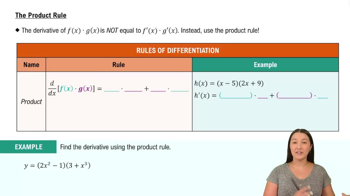
The Product Rule
Quotient Rule
The Quotient Rule is used to differentiate a function that is the ratio of two other functions. If f(x) = u(x)/v(x), the derivative is given by f'(x) = (u'v - uv')/v^2. This rule is crucial when dealing with fractions of functions, ensuring that the differentiation accounts for both the numerator and denominator appropriately.
Recommended video:
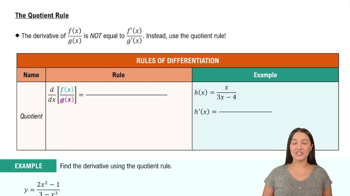
The Quotient Rule
Simplification of Derivatives
Simplification of derivatives involves reducing the expression obtained after differentiation to its simplest form. This may include factoring, combining like terms, or canceling common factors. Simplifying the result is important for clarity and ease of interpretation, especially when further analysis or evaluation of the derivative is required.
Recommended video:

Derivatives
Related Videos
Related Practice



